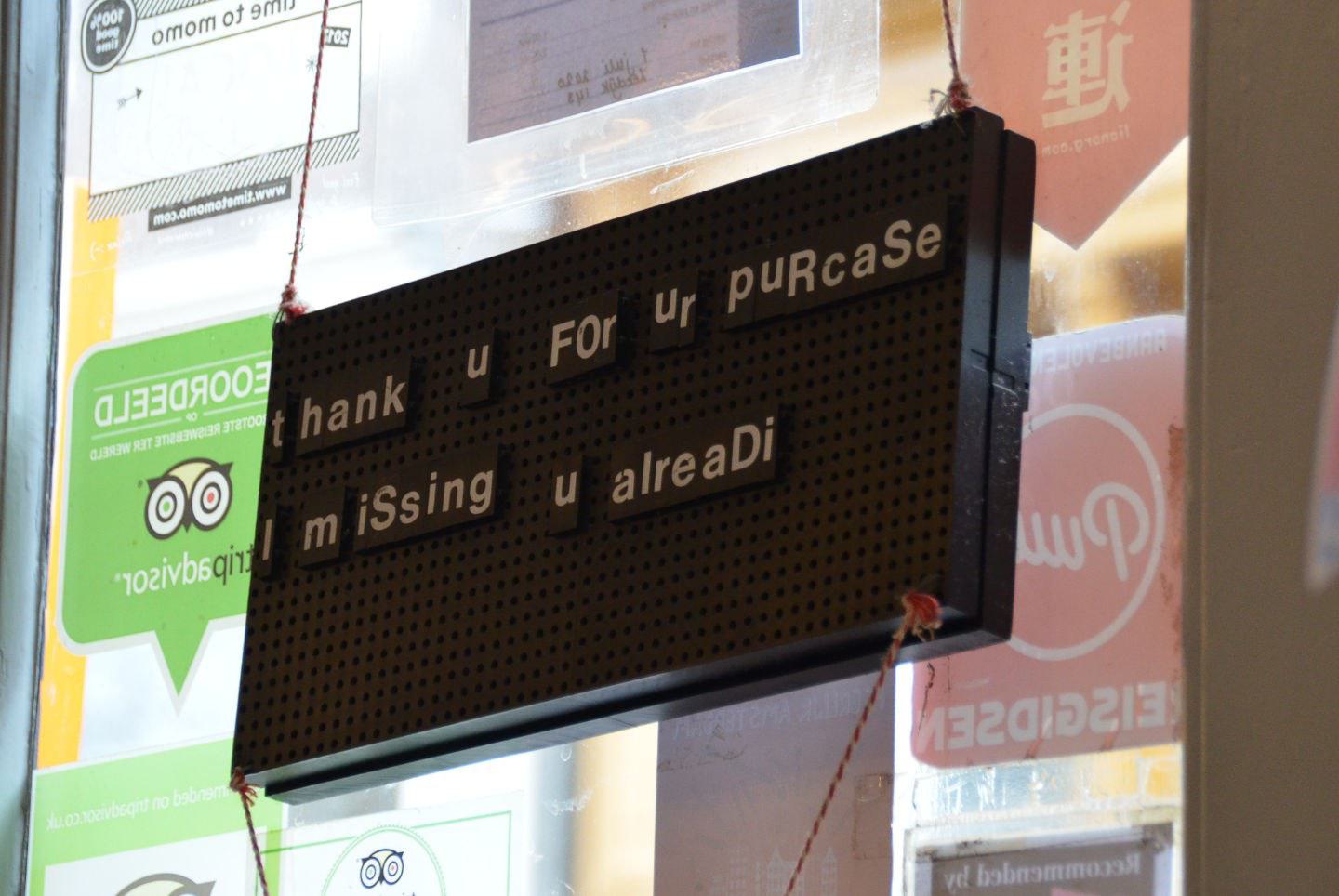Correct spelling, punctuation and better grammar can improve your design
Written by Claire Scaramanga
Spelling, grammar, avoiding the split infinitive, active/passive voice, sentence structure, tense and punctuation are just a few of the unrecognised tools in the designers' arsenal. Why?

Because most designers don't see these as designer traits, but those of another profession. The truth is, they are just as important to the designer as the decisions they make about colour, typography, layout and hierarchy.
Understandably, to some, this will seem an unnecessary burden, however, even a small amount of knowledge in this area can really broaden your approach when tackling a new design problem.
This article does not provide instruction on how to improve your own skills in any specific area, but it does take a holistic look at the benefits of improving your writing skills.
A product of our time
I was schooled (by the state) in the United Kingdom during the late 70s, early 80s and I have absolutely no recollection of being taught grammar or punctuation. It just wasn't a priority.
In their wisdom, the powers of the day decided that they wanted to encourage self-expression in children and felt grammar/punctuation got in the way of achieving this goal. Unfortunately, the product of this radical thinking was not a generation of Bohemian artists but, instead, a generation of individuals missing a few (in my opinion) essential life skills.
I am a product of this generation. I am also a designer, which you could argue adds credence to the success of their social experiment, but I believe a great disservice was done to my generation – especially in an age where we are able to publish what we have written at a click of a button.
In my case, I was unaware that I was lacking these valuable writing skills until I needed them the most: for my job.
Getting out of a sticky situation
My career had taken me from being a designer to manager, which meant I was responsible for a number of clients and projects as well as a team of designers and developers. It also meant I spent a lot more time writing – from composing an email to my colleagues or writing a proposal. It was the latter task that highlighted my inadequacies in writing, so I had to do something about it.
Time to find a good book.
I started with a jaunt through the English language with Lynn Stopps' 'Eats, Shoots and Leaves'. This is a great read even if your are not looking to improve your writing skills.
Then a few invaluable text books that I still use as a reference today:
- My Grammar and I (or should that be 'Me'?) by Caroline Taggart and J.A. Wines
- Good Punctuation by Graham King
- Improve your written English by Marion Field
As good as these books are, I still find I have the occasional question. Thankfully we have been blessed with the Internet. You will be amazed that what you thought was an obscure question has already been posed (and answered) by a similar inquisitive mind. So if you don't have an English Professor at your beck-and-call then you know where to look.
Practise makes perfect
Reading is a fantastic way to expand your knowledge, but reading text books on grammar and punctuation alone will not suddenly create a novelist out of you. It requires practise, care and confidence. Oh, and some more practise.
I am sure you understand the concept of improving your skills by practise, you've been doing it since you were born, but when it comes to writing you need to have the confidence to keep on trying. Sure, things may go wrong. We are all prone to the occasional slip up – often caused by not taking enough time to check what you have written – so this is where the care part comes in. When you write anything (including firing off a quick response email to a colleague), re-read it before pushing the send button. In fact, I would also encourage you to read it aloud as this will highlight any mistakes your eyes can easily skip over. Reading aloud will also allow you to judge the pace and tone of what you have written. As a general rule, if it sounds right then it is more likely that it will be correctly interpreted by its recipient. Then make any necessary edits to your copy, read it again and if necessary make any final edits.
Don't rely on a spell checker. Just because the words are spelt correctly doesn't mean they are the right words. A big faux pas I once made was to send an email to a client that contained the words, “…my, you've been a busty little bee." Clearly, it was not my intention to talk about the size of her anatomy.
You also need to be critical about what you have written. Ask yourself if you have used three words when one will do. Have you used a word that may require the recipient to dust off their dictionary? Have you used technical terminology or an unqualified acronym? Have you considered the tone of voice and how the recipient will interpret what you have written? Does it sound like it has been written by you?
Making you a better designer through words
You are probably wondering how all this relates to being a designer. Clearly, improving your mastery of the English language will improve your prospects, irrespective of what industry sector you work in, but for a designer there are many benefits.
Let's look at one. Consider the scenario where you've been asked by a new client to help them market their product. You are dealing with the marketing department, who have provided you with the copy, however, you feel it doesn't pack enough punch. You have a couple of options. You could go back to your client and suggest they rewrite some of the copy. You will need to clearly articulate what you think needs improving and this process will take time – time the project may not have. Alternatively, you could suggest that you could have a go at modifying the copy. If they don't like your alternative, then you can always revert back to the original.
Of course, this new creative freedom places some responsibility on your shoulders, but it also means you can manipulate the copy to work with the design you've been working on – rather than shoehorn a visual direction to match the copy you've been supplied. You may also find that being creative with the copy, will lead to new ideas for the design. However, the most important thing about this approach is it ensures you are thinking of the overall communication – from the copy to visual aesthetic.
The benefit to the client
Put yourself in your client's shoes. In the scenario described above, their designer is showing them more tenacity and ambition than they may have experienced elsewhere. They have nothing to loose, except perhaps a little pride if they've written the copy. However, in my experience most marketeers value their designer's input. Think about it. Your client sees the designer as an expert communicator. If they wanted someone to produce a pretty picture, then they would have commissioned an artist or illustrator. So if you pitch it correctly, then all you are doing is demonstrating that you are truly interested in the project's success.
Of course, there is the possibility that you'll get it wrong, however, the chances of you getting it right are far greater – especially if you fully understand your client's ambitions and the project's goals. And don't be afraid to make it clear that you are not a copy writer. All you are doing is exploring a different approach. In my experience, the copy I have written and submitted is warmly received and is often used in the final project.
A good example of this in action is the landing page created for Power Farming. The copy was originally written by our client, then rewritten by me. The Power Farming's editorial team made a few minor tweaks, but between us we created a page where the copy matches the design and vice versa.
More gain, less pain
Obviously, you won't know if the copy needs changing until you have read it, but read it you must. Without doing so you will not understand the purpose of the project. Even if you decide you don't need to alter anything, you may discover something that you had not picked up on before – saving you precious time when designing a website, poster or or whatever design project you are working on.
Of course, it may be unfeasible to read everything you've been supplied by your client, especially if you are working on a large website. Therefore, choose pages that will have the most exposure like the home page, section pages, key product/service pages etc. and randomly select a few others.
An important tip is to always keep in mind what the user will want to read when you assess the copy. Your client is likely to write copy from their perspective, i.e. focussing on what they want to say rather than what the user wants to hear, so try to find the balance between the needs of both audiences.
Finally
Not every project will require you to completely rewrite the copy, but look out for opportunities where your intervention may help deliver a creative solution that wouldn't have been possible without adapting the copy.
So next time you are designing a banner advert or email template, a 404 error page or home page, a one-page or full-scale website, a poster or leaflet see if you can improve the message by tweaking the copy – even if it's just a headline.
Disclaimer
This article has been written to highlight the benefits to a designer and does not suggest a designer should be seen as a replacement of a professional copy writer. I'm a designer and my writing style (with its flaws) is something I've developed over a number of years. My style is not appropriate for every client, but for some it is perfect. Your goal should always be to find a tone-of-voice that will resonate with its audience. If in doubt, my advice is to hire a professional.


